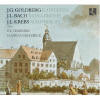Texte paru dans: / Appeared in:

Fanfare Magazine: 36:2 (11-12/2012)
Pour
s'abonner / Subscription information
Les abonnés à Fanfare Magazine ont accès aux archives du
magazine sur internet.
Subscribers to Fanfare Magazine have access to the archives of the magazine
on the net.
Ricercar
RIC317

5400439003170 (ID219)
Consultez toutes les évaluations recensées pour ce cd
~~~~ Reach all the evaluations located for this CD
Yes, this is the one and the same Johann Gottlieb Goldberg (1727–56) who anecdotally lullabied Count Kaiserling to sleep with Bach’s variations. In his brief life, Goldberg didn’t compose a large volume of music, but his catalog of extant works is a bit more diverse than the few current recorded listings, or Fanfare’s Archive, would suggest, as is evidenced here by two of his cantatas.
Goldberg and Johann Ludwig Krebs (1713–80) were both students of the elder Bach, while Johann Ludwig Bach (1677–1731) is identified by most sources as an older second cousin of Johann Sebastian Bach. I was momentarily thrown by Florian Heyerick’s album note, which identifies Ludwig Bach as Johann’s nephew, a chronological, not to mention biological, improbability, since that would make the uncle (Johann) younger than the nephew (Ludwig). I suppose it’s possible, given the way the extended Bach family proliferated like rabbits, but I’m fairly confident that the other sources I checked have it right in identifying Ludwig as a cousin.
The three composers on this disc have something else in common as well, besides two of them being students of Bach and one of them being a relative. If one is to believe Heyerick’s note, after about 1725, the great Leipzig Kantor, Johann Sebastian, began to slack off in his duty to provide a steady stream of cantatas for Sunday and holiday services at the churches of St. Thomas and St. Nicholas. On the face of it, that seems like another improbable assertion, considering that in 1725, Bach had been at the job for only two years, having assumed the post in 1723. But according to Heyerick, Bach was already scheduling cantatas by other composers, namely Telemann, Hoffman, Durante, Fasch, Stölzel, Graun, Conti, Kuhnau, and his nephew (sic) Johann Ludwig.
While I can’t speak to the claim that Bach appropriated works by all of those composers, it seems that it’s true at least regarding Johann Ludwig, for a website, jan.ucc.nau.edu/~tas3/familyhis.html, confirms that in 1726 Bach copied and performed 18 cantatas by Johann Ludwig, which jibes with Heyerick’s note. Incidentally, the web source demotes Johann Ludwig from second cousin to third. Soon, poor Ludwig may drop off the family tree altogether.
What strikes me a bit odd is the inclusion on this disc of J. L. Bach’s Missa brevis—a Latin Kyrie followed by the full four stanzas of the Lutheran hymn Allein Gott in der Höh’ sei Ehr, which corresponds, as I’m given to understand, to the Gloria of the Latin Mass. Strictly speaking, this is not a cantata and probably would not have been among the 18 of J. L. Bach’s two-dozen sacred cantatas presented by J. S. Bach at regular Sunday services.
It’s doubtful that any of the congregants or church administrators would have been fooled into thinking this piece was by their own Kantor. The musical speech patterns are comparatively unsophisticated and the text settings are predominantly homophonic with a lot of ha-ha-ha-ing and tra-la-la-ing.
Goldberg’s cantata Durch die herzliche Barmherzigkeit, composed for John the Baptist Fest (June 24), is an altogether different matter. It would not have too hard a time passing for an authentic work by Johann Sebastian himself. The choral writing is much more contrapuntal than Johann Ludwig’s, and Goldberg’s recitatives, solo arias, and chorales closely mimic J. S.’s melodic contours and harmonic vocabulary. The same may be said of Goldberg’s setting of Psalm 12, Herr, die Heiligen haben abgenommen (Help, Lord, for the Godly Man Ceaseth). For those who can’t get enough of J. S. Bach’s cantatas, here are two surrogate works by one of his students that are sure to please.
Goldberg, born in 1727, may have been younger than Johann Ludwig Krebs (1713–80), but Goldberg died at 29, only six years after his teacher, Johann Sebastian. Krebs, on the other hand, lived a more normal lifespan, leading one to expect a composer whose musical style would be at least contemporary to that of J. S.’s sons Carl Philipp Emanuel and Johann Christian, if not to that of Haydn and Mozart, but that assumption turns out to be false. Krebs spent practically his entire career as an organist in and around Leipzig and his entire life idolizing the music of his onetime teacher, J. S. Bach. Evidence of his arrested development, if you will, can be heard here in his very beautiful German Magnificat, Meine Seele erhebt den Herrn, which pays homage to Bach in its sturdy polyphonic style and downplaying, according to Heyerick, of “the Italianate galanterie that was then in fashion.” “The style of his vocal works,” continues Heyerick, “is very little advanced from that of the Baroque motet.”
The four vocal soloists perform admirably and, thankfully, the choristers and instrumentalists who make up the Ex Tempore ensemble are of the ample numbers we used to see in the good old days of Baroque choirs and orchestras: 30 voices in the main choir, seven voices in the children’s choir that intones the cantus firmus in J. L. Bach’s Missa brevis, and 19 players in the orchestra, admittedly not all of whom play in all four works. Still, Ex Tempore is capable of delivering a solid, weighty, and robust sound.
This release is recommended to those with an interest in choral music by composers who were part of J. S. Bach’s Leipzig circle of apprentices and associates.
Cliquez l'un ou l'autre
bouton pour découvrir bien d'autres critiques de CD
Click either button for many other reviews


